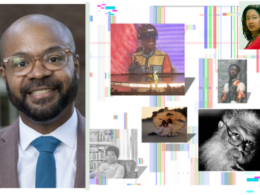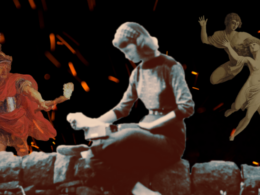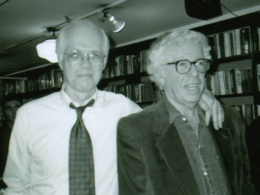Published in September 2015, Library of America’s two-volume anthology Women Crime Writers of the 1940s & 50s collects eight novels that reclaim an extraordinarily rich vein of American crime writing. A Library of America best seller, the set has been called “an irresistible octet of suspense and surprise” by The New York Times Book Review, while The Wall Street Journal declared that the eight novels “are all exceptionally fine, as much so as any of the crime novels written by men that were published in this country in the 1940s and 1950s.”
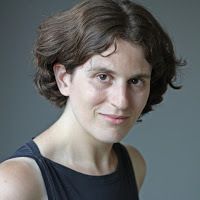
The collection’s editor is Sarah Weinman, who also edited Troubled Daughters, Twisted Wives: Stories from the Trailblazers of Domestic Suspense (2013), which the Los Angeles Review of Books called “one of the most significant anthologies of crime fiction, ever.” She is the news editor for Publishers Marketplace and her work has appeared in The New York Times, The Wall Street Journal, The Los Angeles Times, and The Washington Post, among other publications.
Via email, Weinman offered some historical context for the eight novels in the anthology, and discussed why mystery and suspense fiction written by women seems to resonate so strongly with contemporary readers.
LOA: What was the single biggest discovery you made in preparing Women Crime Writers?
Weinman: I’m not certain there was a “single biggest.” It’s more that there were so many wonderful women writing suspense in the 1940s and ’50s in great need of rediscovery and revival. Patricia Highsmith we know, and to a lesser extent Dorothy B. Hughes and Charlotte Armstrong and Margaret Millar, but Helen Eustis and Dolores Hitchens were almost completely forgotten, Vera Caspary was known, if at all, for providing source material for the film Laura, and Elisabeth Sanxay Holding not so well known. Now they’re all a little better known.
LOA: What were these women writers doing that was new? Do you see any influence from previous writers, either from the crime fiction tradition or outside it?
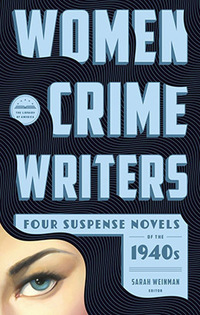
Weinman: They were looking at the world with greater psychological insight and sharp observation, telling the stories of ordinary people—especially women, be they wives, daughters, young and not-so-young single people—who end up in circumstances where fear and anxiety rule. They didn’t fit into the Golden Age detective stories of the 1920s–’30s, nor did they necessarily fit alongside the American male hardboiled tradition of Chandler/Hammett/Cain, etc. They had their own stories to tell, and in distinct, sometimes ruthless ways.
That said, these women couldn’t help but be influenced by those who came before them, such as Eric Ambler, especially for Dorothy B. Hughes. Those “Golden Agers,” especially Christie and Sayers but Allingham and Marsh, too. I see a lot of direct and indirect influence of Francis Iles’s Malice Aforethought (1931), one of the first psychological suspense novels, and Marie Belloc Lowndes’s The Lodger (1914) a generation before that.
LOA: LOA’s online companion to Women Crime Writers features appreciations of all eight novels by leading contemporary crime writers. Is there a direct line of influence from these novels to today’s crime fiction?
Weinman: Definitely, and that’s why I approached the writers I did. Laura Lippman is absolutely our Margaret Millar, and Megan Abbott is unmistakably influenced by Dorothy Hughes. Separately, Gillian Flynn has written about being influenced in a major way by Patricia Highsmith. In other cases, the influence was more unconscious, laying the groundwork for contemporary crime fiction even if the current authors weren’t fully aware of it. Which is why when you look at current suspense novelists selling extraordinarily well, including Tana French and Paula Hawkins, you also have to look back at those who preceded them.
LOA: Several of these novels and their authors fell into relative obscurity between now and the time they were initially published. Why did that happen?
Weinman: A number of reasons. First, the mini-boom in paperback reissues of midcentury pulp novels by the likes of Black Lizard, which began in the 1980s, concentrated primarily on male writers. Second, many of the the key women writing suspense fiction at the time were still in print. It was only later, in the early- to mid-1990s, after they were nearly all dead, that their work fell out of circulation. Other cultural factors included changing tastes, as mystery readers gravitated, on one extreme, to serial killer fiction and on the other extreme to lighter-hearted cozies.
But certainly since the 2008 crash, and particularly in the last five years, contemporary psychological suspense by women has been a huge draw. Why wouldn’t we want to know about the generations who preceded them?
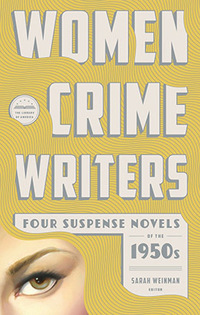
LOA: These eight books take us from the dawn of the 1940s to the tail end of the ’50s—a good chunk of the American midcentury. Do you see any evolution in subject, theme, or character across that time?
Weinman: The 1940s novels had so much to do with World War II, overtly or otherwise. The country had to band together, the men were off to war by the millions, and women stayed to work, which led to changing gender norms. But it’s the aftermath that proved such fascinating fodder (especially seen in Hughes’s In a Lonely Place) where men felt displaced, traumatized, even prone to violence. The gender “norms” were supposed to go back the way they were.
Except they didn’t, and you can see that in the 1950s novels. Nuclear families behaving the opposite. Marriages going toxic. Babysitters going psycho. Bored teenagers setting up scores for kicks, with disastrous results. America was fake and fearful, believing that nuclear war was imminent. And that lent plenty of grist for the mill that was domestic suspense in particular.
LOA: Could you identify a favorite novel among the eight in the set? A favorite scene?
Weinman: I do keep going back to Hughes’s In a Lonely Place above all, it is so stunning and fresh with each new read.
LOA: Since publication the Women Crime Writers set has received enthusiastic reviews and other press coverage not only across the U.S. but in Canada, Ireland, and Hong Kong as well. Have you been surprised by the extent of the attention?
Weinman: Have I ever. You hope for a great response but the level wildly exceeded expectations. It’s a testament to readers wanting to know more about these novels and this time in American literature and the specific ways they looked upon society—and reflect what we fear and are anxious about today.
Visit the special Women Crime Writers companion website for complete information on the eight novels and their authors, along with appreciations by contemporary writers and a wealth of contextual material.
